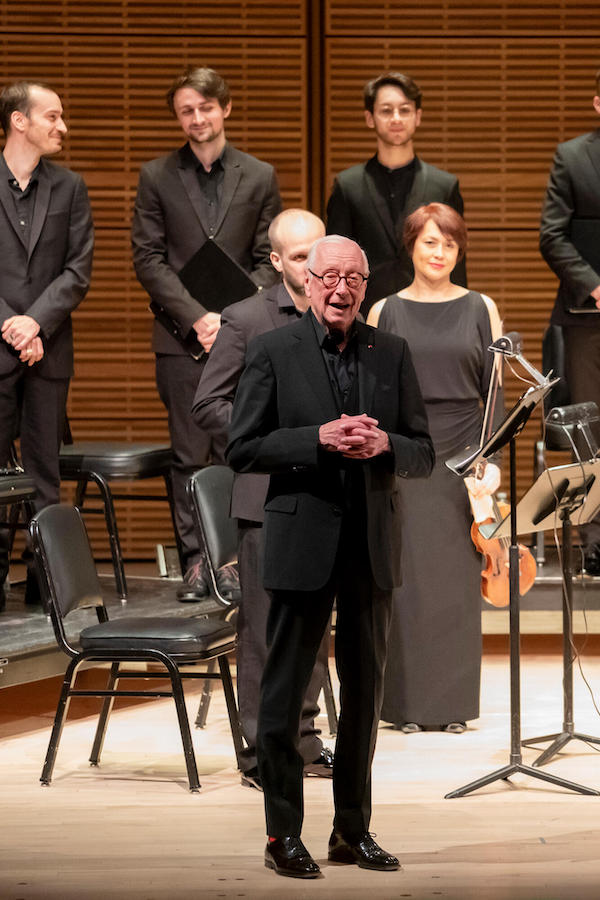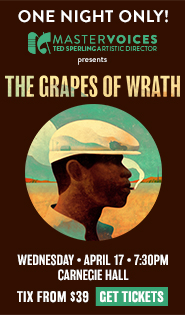Les Arts Florissants returns in a moving program of spiritual Charpentier

Les Arts Florissants returned to Carnegie Hall Wednesday with a contemplative program entitled “Music for Holy Week,” featuring works by Marc-Antoine Charpentier. The concert was performed by nine male singers and an instrumental consort comprised of strings, winds and theorbo, with William Christie conducting and playing the organ.
The French Baroque composer has long been championed by the American-born conductor. Largely due to Christie’s ground-breaking performances of Charpentier’s operas, today’s audiences associate the French composer’s name with the genre. His contemporaries however esteemed his skill in writing sacred vocal music, first at the court of Marie de Lorraine, duchesse de Guise, and subsequently at the Église Saint-Louis and Sainte-Chapelle in Paris.
The first work of the program was Méditations pour le Carême comprised of ten motets that were intended to be performed between the lengthy sermons at Lenten services. The texts tell the story of Christ’s Passion, supplemented by settings of hymns and other poems. Accompanied by a continuo of viola da gamba, violone, and organ, the motets ranged from the meditative to vivid settings of the scenes from the Passion.
In “Ecce Judas,” Christie and his forces created a sense of urgency as the story of Judas’s betrayal was told. The final words, lamenting that it was better that such a man never have been born, were delivered in a chilling unison. A complete change of mood followed with “Cum cenasset Jesus,” which relates Peter’s denial of Christ. The opening section relating the breaking of bread and sharing of wine at the Last Supper was followed by an intense setting of the Apostle Peter’s denial of Christ. The final words that told of his remorse fell like waves of tears.
Of the hymns and other settings, “Sicut pullus hirundinis,” was particularly beautiful for the sensitivity that the musicians brought to a simple prayer that yearns for a reflective, peaceful life. Charpentier’s setting of the hymn, “Stabat Mater,” was performed with a quiet fervor that captured the desolation and sorrow of Mary over the death of her son. The final motet, “Tentavit Deus Abraham,” was a powerful telling of the story of the Sacrifice of Abraham, ending with a chilling recitation of the father with knife in hand ready to slay his son.
Two of Charpentier’s Leçons de ténèbres were heard in the final section of the concert, as well as a Responsory from the Second Nocturne for Holy Thursday. Tenebrae services are conducted in near darkness, with the few candles lighting the church extinguished one by one until the congregation is left sitting in gloomy silence. By Charpentier’s time, the restrictions that the texts be sung only in Gregorian chant had been eased and the elaborate vocal settings were accompanied by high melody instruments and low continuo instruments.
The “Third Tenebrae Lesson for Holy Thursday,” a setting from the Book of Lamentations by the Old Testament prophet Jeremiah, brought a startling change in musical textures with the addition of violins and flutes to the ensemble. Charpentier set the text for solo voice, here performed by the excellent baritone Igor Bouin.
Bouin was a master of depicting the meaning of the words by inflecting the more reflective texts with a profound gravity and the more dramatic utterances with boldness. His ornamentation, often performed in unison with the instruments, was subtle and perfectly executed,
The Responsory for Holy Thursday is a setting of the New Testament passage where the dying Jesus commends his spirit to God. Bass Cyril Costanzo instilled Jesus’s final words with anguish and eloquence, which was echoed in the playing of the violins and continuo. As the music tapered off, it was as if Christie caught the moment of death in a tender, sad exhale.
The concluding work was the “Third Tenebrae Lesson for Holy Friday,” with text also taken from the Lamentations. The wailing of the winds in the prelude evoked the agony of the prophet rueing the total destruction of Jerusalem. Each vocal entrance in the fugal sections increased the desperation, culminating in a harrowing depiction of chaos.
Charpentier set the final words of the lesson, “Jerusalem, Jerusalem,” as a motet. Christie led his musicians in a performance of this serene music that made a moving, exquisitely beautiful conclusion to this sublime concert.




